中国全科医学 ›› 2023, Vol. 26 ›› Issue (08): 997-1007.DOI: 10.12114/j.issn.1007-9572.2022.0535
所属专题: 神经系统疾病最新文章合辑; 运动相关研究最新文章合辑; 脑健康最新研究合辑
熊丹1,2, 谢海花1,2, 李浩2, 张泓1, 谭洁1,*( ), 赵宁2,*(
), 赵宁2,*( )
)
收稿日期:2022-03-23
修回日期:2022-09-10
出版日期:2023-03-15
发布日期:2022-11-24
通讯作者:
谭洁, 赵宁
基金资助:
XIONG Dan1,2, XIE Haihua1,2, LI Hao2, ZHANG Hong1, TAN Jie1,*( ), ZHAO Ning2,*(
), ZHAO Ning2,*( )
)
Received:2022-03-23
Revised:2022-09-10
Published:2023-03-15
Online:2022-11-24
Contact:
TAN Jie, ZHAO Ning
摘要: 背景 上肢运动功能障碍是脑卒中后常见的后遗症之一,严重影响患者日常生活能力。重复经颅磁刺激(rTMS)作为常见的神经电生理技术对治疗脑卒中后上肢运动功能障碍有较好的疗效,但临床对不同rTMS干预模式的选择仍缺乏循证依据。 目的 采用网状Meta分析方法比较rTMS的4种模式对脑卒中后上肢运动功能障碍患者的临床疗效。 方法 计算机检索PubMed、Embase、Cochrane Library、Web of Science、中国生物医学文献数据库、中国知网、万方数据知识服务平台、维普网中有关rTMS治疗脑卒中后上肢运动功能障碍的随机对照试验,并通过追溯Meta分析的参考文献作为补充。检索时间均为建库至2022年2月,采用主题词和自由词结合方式进行。2名研究者进行文献筛选、资料提取及质量评价。采用RevMan 5.0软件和Stata 16.0软件进行统计学分析。 结果 最终纳入17篇文献,790例患者,共涉及6种干预措施:高频rTMS(HF-rTMS)、低频rTMS(LF-rTMS)、间断性theta节律刺激(iTBS)、连续性theta节律刺激(cTBS)、假刺激、常规疗法。网状Meta分析结果显示,HF-rTMS、LF-rTMS提高脑卒中后上肢功能障碍患者Fugl-Meyer运动评分量表上肢部分(FMA-UE)评分均高于假刺激、常规疗法(P<0.05),cTBS提高脑卒中后上肢功能障碍患者FMA-UE评分高于常规疗法(P<0.05),LF-rTMS提高脑卒中后上肢功能障碍患者改良Barther指数(MBI)和Barther指数(BI)评分均高于假刺激、常规疗法(P<0.05),HF-rTMS、LF-rTMS缩短脑卒中后上肢功能障碍患者运动诱发电位(MEP)潜伏期高于假刺激(P<0.05)。不同措施提高脑卒中后上肢运动功能障碍患者FMA-UE评分的累积排序概率曲线下面积(SUCRA)排序结果显示,LF-rTMS(79.9%)>cTBS(75.3%)>HF-rTMS(71.1%)>iTBS(45.8%)>假刺激(20.2%)>常规疗法(7.7%),降低改良Ashworth量表(MAS)评分的SUCRA排序结果显示,iTBS(77.0%)>LF-rTMS(64.1%)>cTBS(61.0%)>HF-rTMS(38.0%)>假刺激(30.6%)>常规疗法(29.2%),提高MBI和BI评分的SUCRA排序结果显示,LF-rTMS(96.4)>iTBS(74.9%)>HF-rTMS(38.6%)>假刺激(30.7%)>常规疗法(9.4%),缩短MEP潜伏期的SUCRA排序结果显示,HF-rTMS(80.0%)>LF-rTMS(78.9%)>常规疗法(58.8%)>iTBS(24.9%)>假刺激(7.5%)。 结论 现有证据表明,在假刺激及常规疗法对照的基础上,LF-rTMS在改善脑卒中患者上肢运动功能、日常生活能力方面的效果优于HF-rTMS和iTBS、cTBS;iTBS对上肢肌张力的降低具有明显优势;HF-rTMS对皮质脊髓兴奋性的干预效果更佳。
| 步骤 | 检索式 |
|---|---|
| #1 | Transcranial Magnetic Stimulation[MeSH Terms] |
| #2 | Repetitive Transcranial Magnetic Stimulation* OR theta burst stimulation OR TMS OR TBS |
| #3 | #1 OR #2 |
| #4 | Stroke[MeSH Terms] |
| #5 | Cerebrovascular Accident OR Cerebrovascular Apoplexy OR Brain Vascular Accident OR Cerebrovascular Stroke |
| #6 | #4 OR #5 |
| #7 | upper limb[MeSH Terms] |
| #8 | upper limb movement dysfunction OR upper extremity motor dysfunction OR upper extremity movement dysfunction OR upper limb motor impairment |
| #9 | #7 OR #8 |
| #10 | randomized controlled trial[MeSH Terms] |
| #11 | randomized controlled study OR randomized clinical trial OR controlled clinical Trial |
| #12 | #10 OR #11 |
| #13 | #3 AND #6 AND #9 AND #12 |
表1 PubMed数据库检索式
Table 1 Strategy for searching eligible systematic reviews included in PubMed database
| 步骤 | 检索式 |
|---|---|
| #1 | Transcranial Magnetic Stimulation[MeSH Terms] |
| #2 | Repetitive Transcranial Magnetic Stimulation* OR theta burst stimulation OR TMS OR TBS |
| #3 | #1 OR #2 |
| #4 | Stroke[MeSH Terms] |
| #5 | Cerebrovascular Accident OR Cerebrovascular Apoplexy OR Brain Vascular Accident OR Cerebrovascular Stroke |
| #6 | #4 OR #5 |
| #7 | upper limb[MeSH Terms] |
| #8 | upper limb movement dysfunction OR upper extremity motor dysfunction OR upper extremity movement dysfunction OR upper limb motor impairment |
| #9 | #7 OR #8 |
| #10 | randomized controlled trial[MeSH Terms] |
| #11 | randomized controlled study OR randomized clinical trial OR controlled clinical Trial |
| #12 | #10 OR #11 |
| #13 | #3 AND #6 AND #9 AND #12 |
| 第一作者 | 发表时间(年) | 样本量(试验组/对照组) | 年龄(岁) | 性别(男/女) | 偏瘫侧(右/左) | 干预措施 | 结局指标 | ||
|---|---|---|---|---|---|---|---|---|---|
| 试验组 | 对照组 | 试验组 | 对照组 | ||||||
| 肖长林[ | 2019 | 15/17 | 63.7±11.0 | 58.7±10.8 | 21/11 | 15/17 | HF-rTMS | 假刺激 | ①②③ |
| 梁绮婷[ | 2018 | 38/38a | 64.3±11.8 | 65.5±10.5 | 47/31 | — | HF-rTMS | 常规疗法 | ①③ |
| 周哲[ | 2020 | 30/28 | 59.7±10.4 | 61.8±11.4 | 41/17 | 28/30 | HF-rTMS | 假刺激 | ①②③ |
| 王玉琴[ | 2020 | 36/36 | 52.0±6.9 | 53.1±6.8 | 41/31 | 28/44 | LF-rTMS | 假刺激 | ①③④ |
| 刘阅[ | 2018 | 10/13 | 56.9±9.0 | 55.4±8.4 | 14/9 | 9/14 | LF-rTMS | 常规疗法 | ①②③ |
| 李冰洁[ | 2016 | 20/20 | 51.5±7.1 | 51.4±6.6 | 23/17 | 25/15 | LF-rTMS | 常规疗法 | ①③④ |
| GOTTLIEB[ | 2021 | 14/14 | 63.9±10.9 | 62.4±11.5 | 12/16 | 8/20 | LF-rTMS | 假刺激 | ①② |
| SENIÓW[ | 2012 | 20/20 | 63.5±8.9 | 63.4±9.2 | 26/14 | 23/17 | LF-rTMS | 假刺激 | ① |
| 汤昕未[ | 2018 | 8/8 | 53.8±10.8 | 55.6±14.6 | 14/2 | 14/2 | iTBS | 假刺激 | ①③ |
| CHEN[ | 2019 | 11/11 | 52.9±11.1 | 52.6±8.3 | 14/8 | 15/7 | iTBS | 假刺激 | ①② |
| CHEN[ | 2021 | 12/11 | 54.4±10.6 | 48.9±9.6 | 18/5 | 18/5 | iTBS | 假刺激 | ①② |
| CHEN[ | 2021 | 16/16 | 57.4±8.0 | 51.4±9.2 | 7/25 | 13/19 | iTBS | 假刺激 | ③④ |
| KUZU[ | 2021 | 7/6 | 61.3±9.8 | 65.3±4.6 | 8/5 | 8/5 | cTBS | 假刺激 | ①② |
| CHA[ | 2021 | 20/20 | 67.6±7.2 | 69.1±6.0 | 25/15 | — | HF-rTMS | LF-rTMS | ① |
| KONDO[ | 2017 | 71/32 | 62.3±12.5 | 60.0±14.2 | 73/30 | 47/56 | LF-rTMS | cTBS | ① |
| 孟祥民[ | 2016 | 14/17/14b | 57.4±13.3/55.1±12.9 | 51.2±14.1 | 33/12 | 30/15 | HF-rTMS、LF-rTMS | 假刺激 | ①④ |
| LI[ | 2016 | 43/42/42b | 54.0±13.4/57.9±12.9 | 53.1±13.7 | 87/40 | 59/68 | HF-rTMS、LF-rTMS | 假刺激 | ①④ |
表2 纳入文献的基本特征
Table 2 Characteristics of the included studies
| 第一作者 | 发表时间(年) | 样本量(试验组/对照组) | 年龄(岁) | 性别(男/女) | 偏瘫侧(右/左) | 干预措施 | 结局指标 | ||
|---|---|---|---|---|---|---|---|---|---|
| 试验组 | 对照组 | 试验组 | 对照组 | ||||||
| 肖长林[ | 2019 | 15/17 | 63.7±11.0 | 58.7±10.8 | 21/11 | 15/17 | HF-rTMS | 假刺激 | ①②③ |
| 梁绮婷[ | 2018 | 38/38a | 64.3±11.8 | 65.5±10.5 | 47/31 | — | HF-rTMS | 常规疗法 | ①③ |
| 周哲[ | 2020 | 30/28 | 59.7±10.4 | 61.8±11.4 | 41/17 | 28/30 | HF-rTMS | 假刺激 | ①②③ |
| 王玉琴[ | 2020 | 36/36 | 52.0±6.9 | 53.1±6.8 | 41/31 | 28/44 | LF-rTMS | 假刺激 | ①③④ |
| 刘阅[ | 2018 | 10/13 | 56.9±9.0 | 55.4±8.4 | 14/9 | 9/14 | LF-rTMS | 常规疗法 | ①②③ |
| 李冰洁[ | 2016 | 20/20 | 51.5±7.1 | 51.4±6.6 | 23/17 | 25/15 | LF-rTMS | 常规疗法 | ①③④ |
| GOTTLIEB[ | 2021 | 14/14 | 63.9±10.9 | 62.4±11.5 | 12/16 | 8/20 | LF-rTMS | 假刺激 | ①② |
| SENIÓW[ | 2012 | 20/20 | 63.5±8.9 | 63.4±9.2 | 26/14 | 23/17 | LF-rTMS | 假刺激 | ① |
| 汤昕未[ | 2018 | 8/8 | 53.8±10.8 | 55.6±14.6 | 14/2 | 14/2 | iTBS | 假刺激 | ①③ |
| CHEN[ | 2019 | 11/11 | 52.9±11.1 | 52.6±8.3 | 14/8 | 15/7 | iTBS | 假刺激 | ①② |
| CHEN[ | 2021 | 12/11 | 54.4±10.6 | 48.9±9.6 | 18/5 | 18/5 | iTBS | 假刺激 | ①② |
| CHEN[ | 2021 | 16/16 | 57.4±8.0 | 51.4±9.2 | 7/25 | 13/19 | iTBS | 假刺激 | ③④ |
| KUZU[ | 2021 | 7/6 | 61.3±9.8 | 65.3±4.6 | 8/5 | 8/5 | cTBS | 假刺激 | ①② |
| CHA[ | 2021 | 20/20 | 67.6±7.2 | 69.1±6.0 | 25/15 | — | HF-rTMS | LF-rTMS | ① |
| KONDO[ | 2017 | 71/32 | 62.3±12.5 | 60.0±14.2 | 73/30 | 47/56 | LF-rTMS | cTBS | ① |
| 孟祥民[ | 2016 | 14/17/14b | 57.4±13.3/55.1±12.9 | 51.2±14.1 | 33/12 | 30/15 | HF-rTMS、LF-rTMS | 假刺激 | ①④ |
| LI[ | 2016 | 43/42/42b | 54.0±13.4/57.9±12.9 | 53.1±13.7 | 87/40 | 59/68 | HF-rTMS、LF-rTMS | 假刺激 | ①④ |
| 第一作者 | 刺激频率(Hz) | 刺激强度 | 总脉冲数 | 刺激部位 | 线圈类型 | 治疗方案及持续时间 |
|---|---|---|---|---|---|---|
| 肖长林[ | 10 | 90% RMT | 900 | 患侧C3、C4 | "8"字形线圈 | 9 min/次,5次/周,持续2周 |
| 梁绮婷[ | 3 | 90%~120% AMT | 900 | 患侧C3、C4 | "8"字形线圈 | 20 min/次,持续治疗2周后休息2 d,持续8周 |
| 周哲[ | 5 | 80% RMT | 1 200 | 患侧M1 | "8"字形线圈 | 5 min/次,5次/周,持续3周 |
| 王玉琴[ | 1 | 80% AMT | 600 | 健侧M1 | "8"字形线圈 | 10 min/次,5次/周,持续4周 |
| 刘阅[ | 1 | 90% AMT | 1 200 | 健侧M1 | "8"字形线圈 | 24 min/次,5次/周,持续8周 |
| 李冰洁[ | 1 | 80% AMT | 600 | 健侧M1 | "8"字形线圈 | 10 min/次,5次/周,持续2周 |
| GOTTLIEB[ | 1 | 100% RMT | 1 200 | 健侧M1 | "8"字形线圈 | 10 min/次,5次/周,持续2周 |
| SENIÓW[ | 1 | 90% RMT | 1 200 | 健侧M1 | "8"字形线圈 | 30 min/次,5次/周,持续3周 |
| 汤昕未[ | 50-5 | 70% RMT | 600 | 患侧M1 | 圆形线圈 | 200 s/次,5次/周,持续2周 |
| CHEN[ | 50-5 | 80% AMT | 600 | 患侧M1 | "8"字形线圈 | 200 s/次,5次/周,持续2周 |
| CHEN[ | 50-5 | 80% AMT | 1 200 | 健侧M1 | "8"字形线圈 | 200 s/次,5次/周,持续3周 |
| CHEN[ | 50-5 | 80% AMT | 600 | 患侧小脑 | "8"字形线圈 | 200 s/次,5次/周,持续2周 |
| KUZU[ | 50-5 | 80% AMT | 600 | 健侧M1 | "8"字形线圈 | 200 s/次,5次/周,持续2周 |
| CHA[ | 10/1 | 90% RMT | 1 350/1 000 | 患侧M1/健侧M1 | "8"字形线圈 | 20 min/次,5次/周,持续2周 |
| KONDO[ | 1/50-5 | 90% RMT/80% AMT | 2 400 | 运动皮质 | "8"字形线圈 | 20 min/次,6次/周,共2周;160 s/次,6次/周,共2周 |
| 孟祥民[ | 10/1 | 80% AMT | 1 350/1 000 | 健侧M1/患侧M1 | 圆形线圈 | 20 min/次,5次/周,持续2周 |
| LI[ | 10/1 | 80% AMT | 1 350/1 000 | 健侧M1/患侧M1 | 圆形线圈 | 20 min/次,5次/周,持续2周 |
表3 纳入文献的rTMS参数和治疗方案
Table 3 rTMS parameters and treatment regimens in the included studies
| 第一作者 | 刺激频率(Hz) | 刺激强度 | 总脉冲数 | 刺激部位 | 线圈类型 | 治疗方案及持续时间 |
|---|---|---|---|---|---|---|
| 肖长林[ | 10 | 90% RMT | 900 | 患侧C3、C4 | "8"字形线圈 | 9 min/次,5次/周,持续2周 |
| 梁绮婷[ | 3 | 90%~120% AMT | 900 | 患侧C3、C4 | "8"字形线圈 | 20 min/次,持续治疗2周后休息2 d,持续8周 |
| 周哲[ | 5 | 80% RMT | 1 200 | 患侧M1 | "8"字形线圈 | 5 min/次,5次/周,持续3周 |
| 王玉琴[ | 1 | 80% AMT | 600 | 健侧M1 | "8"字形线圈 | 10 min/次,5次/周,持续4周 |
| 刘阅[ | 1 | 90% AMT | 1 200 | 健侧M1 | "8"字形线圈 | 24 min/次,5次/周,持续8周 |
| 李冰洁[ | 1 | 80% AMT | 600 | 健侧M1 | "8"字形线圈 | 10 min/次,5次/周,持续2周 |
| GOTTLIEB[ | 1 | 100% RMT | 1 200 | 健侧M1 | "8"字形线圈 | 10 min/次,5次/周,持续2周 |
| SENIÓW[ | 1 | 90% RMT | 1 200 | 健侧M1 | "8"字形线圈 | 30 min/次,5次/周,持续3周 |
| 汤昕未[ | 50-5 | 70% RMT | 600 | 患侧M1 | 圆形线圈 | 200 s/次,5次/周,持续2周 |
| CHEN[ | 50-5 | 80% AMT | 600 | 患侧M1 | "8"字形线圈 | 200 s/次,5次/周,持续2周 |
| CHEN[ | 50-5 | 80% AMT | 1 200 | 健侧M1 | "8"字形线圈 | 200 s/次,5次/周,持续3周 |
| CHEN[ | 50-5 | 80% AMT | 600 | 患侧小脑 | "8"字形线圈 | 200 s/次,5次/周,持续2周 |
| KUZU[ | 50-5 | 80% AMT | 600 | 健侧M1 | "8"字形线圈 | 200 s/次,5次/周,持续2周 |
| CHA[ | 10/1 | 90% RMT | 1 350/1 000 | 患侧M1/健侧M1 | "8"字形线圈 | 20 min/次,5次/周,持续2周 |
| KONDO[ | 1/50-5 | 90% RMT/80% AMT | 2 400 | 运动皮质 | "8"字形线圈 | 20 min/次,6次/周,共2周;160 s/次,6次/周,共2周 |
| 孟祥民[ | 10/1 | 80% AMT | 1 350/1 000 | 健侧M1/患侧M1 | 圆形线圈 | 20 min/次,5次/周,持续2周 |
| LI[ | 10/1 | 80% AMT | 1 350/1 000 | 健侧M1/患侧M1 | 圆形线圈 | 20 min/次,5次/周,持续2周 |
| 第一作者 | 随机方法 | 盲法 | 分配隐藏 | 结果数据的完整性 | 选择性报告研究结果 | 其他偏倚来源 |
|---|---|---|---|---|---|---|
| 肖长林[ | 随机数字表 | 单盲 | 不清楚 | 有失访 | 否 | 不清楚 |
| 梁绮婷[ | 计算机随机 | 不清楚 | 不清楚 | 无失访 | 否 | 不清楚 |
| 周哲[ | 随机数字表 | 单盲 | 不清楚 | 无失访 | 否 | 不清楚 |
| 王玉琴[ | 随机数字表 | 单盲 | 不清楚 | 无失访 | 否 | 不清楚 |
| 刘阅[ | 随机数字表 | 单盲 | 不清楚 | 无失访 | 否 | 不清楚 |
| 李冰洁[ | 随机数字表 | 不清楚 | 不清楚 | 无失访 | 否 | 不清楚 |
| GOTTLIEB[ | 计算机随机 | 双盲 | 不清楚 | 有失访 | 否 | 不清楚 |
| SENIÓW[ | 计算机随机 | 双盲 | 不清楚 | 意向性分析 | 否 | 不清楚 |
| 汤昕未[ | 计算机随机 | 单盲 | 不清楚 | 无失访 | 否 | 不清楚 |
| CHEN[ | 计算机随机 | 单盲 | 有 | 无失访 | 否 | 不清楚 |
| CHEN[ | 计算机随机 | 双盲 | 不清楚 | 有失访 | 否 | 不清楚 |
| CHEN[ | 随机数字表 | 双盲 | 不清楚 | 意向性分析 | 否 | 不清楚 |
| KUZU[ | 计算机随机 | 双盲 | 不清楚 | 无失访 | 否 | 不清楚 |
| CHA[ | 随机数字表 | 单盲 | 不清楚 | 无失访 | 否 | 不清楚 |
| KONDO[ | 不清楚 | 双盲 | 不清楚 | 有失访 | 否 | 不清楚 |
| 孟祥民[ | 随机数字表 | 不清楚 | 不清楚 | 无失访 | 否 | 不清楚 |
| LI[ | 随机数字表 | 双盲 | 不清楚 | 有失访 | 否 | 不清楚 |
表4 纳入文献的偏倚风险评价结果
Table 4 Risk of bias of the included studies
| 第一作者 | 随机方法 | 盲法 | 分配隐藏 | 结果数据的完整性 | 选择性报告研究结果 | 其他偏倚来源 |
|---|---|---|---|---|---|---|
| 肖长林[ | 随机数字表 | 单盲 | 不清楚 | 有失访 | 否 | 不清楚 |
| 梁绮婷[ | 计算机随机 | 不清楚 | 不清楚 | 无失访 | 否 | 不清楚 |
| 周哲[ | 随机数字表 | 单盲 | 不清楚 | 无失访 | 否 | 不清楚 |
| 王玉琴[ | 随机数字表 | 单盲 | 不清楚 | 无失访 | 否 | 不清楚 |
| 刘阅[ | 随机数字表 | 单盲 | 不清楚 | 无失访 | 否 | 不清楚 |
| 李冰洁[ | 随机数字表 | 不清楚 | 不清楚 | 无失访 | 否 | 不清楚 |
| GOTTLIEB[ | 计算机随机 | 双盲 | 不清楚 | 有失访 | 否 | 不清楚 |
| SENIÓW[ | 计算机随机 | 双盲 | 不清楚 | 意向性分析 | 否 | 不清楚 |
| 汤昕未[ | 计算机随机 | 单盲 | 不清楚 | 无失访 | 否 | 不清楚 |
| CHEN[ | 计算机随机 | 单盲 | 有 | 无失访 | 否 | 不清楚 |
| CHEN[ | 计算机随机 | 双盲 | 不清楚 | 有失访 | 否 | 不清楚 |
| CHEN[ | 随机数字表 | 双盲 | 不清楚 | 意向性分析 | 否 | 不清楚 |
| KUZU[ | 计算机随机 | 双盲 | 不清楚 | 无失访 | 否 | 不清楚 |
| CHA[ | 随机数字表 | 单盲 | 不清楚 | 无失访 | 否 | 不清楚 |
| KONDO[ | 不清楚 | 双盲 | 不清楚 | 有失访 | 否 | 不清楚 |
| 孟祥民[ | 随机数字表 | 不清楚 | 不清楚 | 无失访 | 否 | 不清楚 |
| LI[ | 随机数字表 | 双盲 | 不清楚 | 有失访 | 否 | 不清楚 |

图2 不同rTMS干预模式治疗脑卒中后上肢运动功能障碍的证据网络图注:A为高频重复经颅磁刺激(HF-rTMS),B为低频重复经颅磁刺激(LF-rTMS),C为间断性theta节律刺激(iTBS),D为连续性theta节律刺激(cTBS),E为假刺激,F为常规疗法;FMA-UE=Fugl-Meyer运动评分量表上肢部分,MAS=改良Ashworth量表,MBI=改良Barthel指数,MEP=运动诱发电位
Figure 2 Evidence network plot of different modalities of rTMS intervention for upper limb motor dysfunction after stroke
| 干预方案 | HF-rTMS | LF-rTMS | iTBS | cTBS | 假刺激 |
|---|---|---|---|---|---|
| LF-rTMS | -0.06(-0.37,0.24) | — | — | — | — |
| iTBS | 0.24(-0.39,0.86) | 0.30(-0.31,0.92) | — | — | — |
| cTBS | -0.06(-0.63,0.52) | 0.00(-0.50,0.51) | -0.30(-1.07,0.48) | — | — |
| 假刺激 | 0.47(0.17,0.78)a | 0.54(0.26,0.82)a | 0.24(-0.31,0.78) | 0.53(-0.02,1.09) | — |
| 常规疗法 | 0.66(0.21,1.10)a | 0.72(0.28,1.16)a | 0.42(-0.31,1.15) | 0.71(0.05,1.37)a | 0.18(-0.30,0.67) |
表5 不同rTMS干预模式提高脑卒中后上肢运动障碍患者FMA-UE评分的网状Meta分析〔SMD(95%CI)〕
Table 5 Network meta-analysis of different modalities of rTMS intervention in increasing the FMA-UE score for stroke patients with upper limb motor dysfunction
| 干预方案 | HF-rTMS | LF-rTMS | iTBS | cTBS | 假刺激 |
|---|---|---|---|---|---|
| LF-rTMS | -0.06(-0.37,0.24) | — | — | — | — |
| iTBS | 0.24(-0.39,0.86) | 0.30(-0.31,0.92) | — | — | — |
| cTBS | -0.06(-0.63,0.52) | 0.00(-0.50,0.51) | -0.30(-1.07,0.48) | — | — |
| 假刺激 | 0.47(0.17,0.78)a | 0.54(0.26,0.82)a | 0.24(-0.31,0.78) | 0.53(-0.02,1.09) | — |
| 常规疗法 | 0.66(0.21,1.10)a | 0.72(0.28,1.16)a | 0.42(-0.31,1.15) | 0.71(0.05,1.37)a | 0.18(-0.30,0.67) |
| 干预方案 | FMA-UE | MAS | MBI/BI | MEP潜伏期 | ||||||||
|---|---|---|---|---|---|---|---|---|---|---|---|---|
| SUCRA值(%) | 最优概率(%) | 平均排序 | SUCRA值(%) | 最优概率(%) | 平均排序 | SUCRA值(%) | 最优概率(%) | 平均排序 | SUCRA值(%) | 最优概率(%) | 平均排序 | |
| HF-rTMS | 71.1 | 20.1 | 2.4 | 38.0 | 2.6 | 4.1 | 38.6 | 0 | 3.5 | 80.0 | 43.8 | 1.8 |
| LF-rTMS | 79.9 | 29.2 | 2.0 | 64.1 | 14.7 | 2.8 | 96.4 | 85.6 | 1.1 | 78.9 | 33.2 | 1.8 |
| iTBS | 45.8 | 9.8 | 3.7 | 77.0 | 45.5 | 2.1 | 74.9 | 14.4 | 2.0 | 24.9 | 2.1 | 4.0 |
| cTBS | 75.3 | 40.9 | 2.2 | 61.0 | 31.0 | 2.9 | — | — | — | — | — | — |
| 假刺激 | 20.2 | 0 | 5.0 | 30.6 | 0.2 | 4.5 | 30.7 | 0 | 3.8 | 7.5 | 0 | 4.7 |
| 常规疗法 | 7.7 | 0 | 5.6 | 29.2 | 6.1 | 4.5 | 9.4 | 0 | 4.6 | 58.8 | 20.9 | 2.7 |
表6 不同rTMS干预模式对脑卒中后上肢运动障碍患者干预效果的SUCRA排序表
Table 6 SUCRA probabilities for the effectiveness of different modalities of rTMS intervention in stroke patients with upper limb motor dysfunction
| 干预方案 | FMA-UE | MAS | MBI/BI | MEP潜伏期 | ||||||||
|---|---|---|---|---|---|---|---|---|---|---|---|---|
| SUCRA值(%) | 最优概率(%) | 平均排序 | SUCRA值(%) | 最优概率(%) | 平均排序 | SUCRA值(%) | 最优概率(%) | 平均排序 | SUCRA值(%) | 最优概率(%) | 平均排序 | |
| HF-rTMS | 71.1 | 20.1 | 2.4 | 38.0 | 2.6 | 4.1 | 38.6 | 0 | 3.5 | 80.0 | 43.8 | 1.8 |
| LF-rTMS | 79.9 | 29.2 | 2.0 | 64.1 | 14.7 | 2.8 | 96.4 | 85.6 | 1.1 | 78.9 | 33.2 | 1.8 |
| iTBS | 45.8 | 9.8 | 3.7 | 77.0 | 45.5 | 2.1 | 74.9 | 14.4 | 2.0 | 24.9 | 2.1 | 4.0 |
| cTBS | 75.3 | 40.9 | 2.2 | 61.0 | 31.0 | 2.9 | — | — | — | — | — | — |
| 假刺激 | 20.2 | 0 | 5.0 | 30.6 | 0.2 | 4.5 | 30.7 | 0 | 3.8 | 7.5 | 0 | 4.7 |
| 常规疗法 | 7.7 | 0 | 5.6 | 29.2 | 6.1 | 4.5 | 9.4 | 0 | 4.6 | 58.8 | 20.9 | 2.7 |
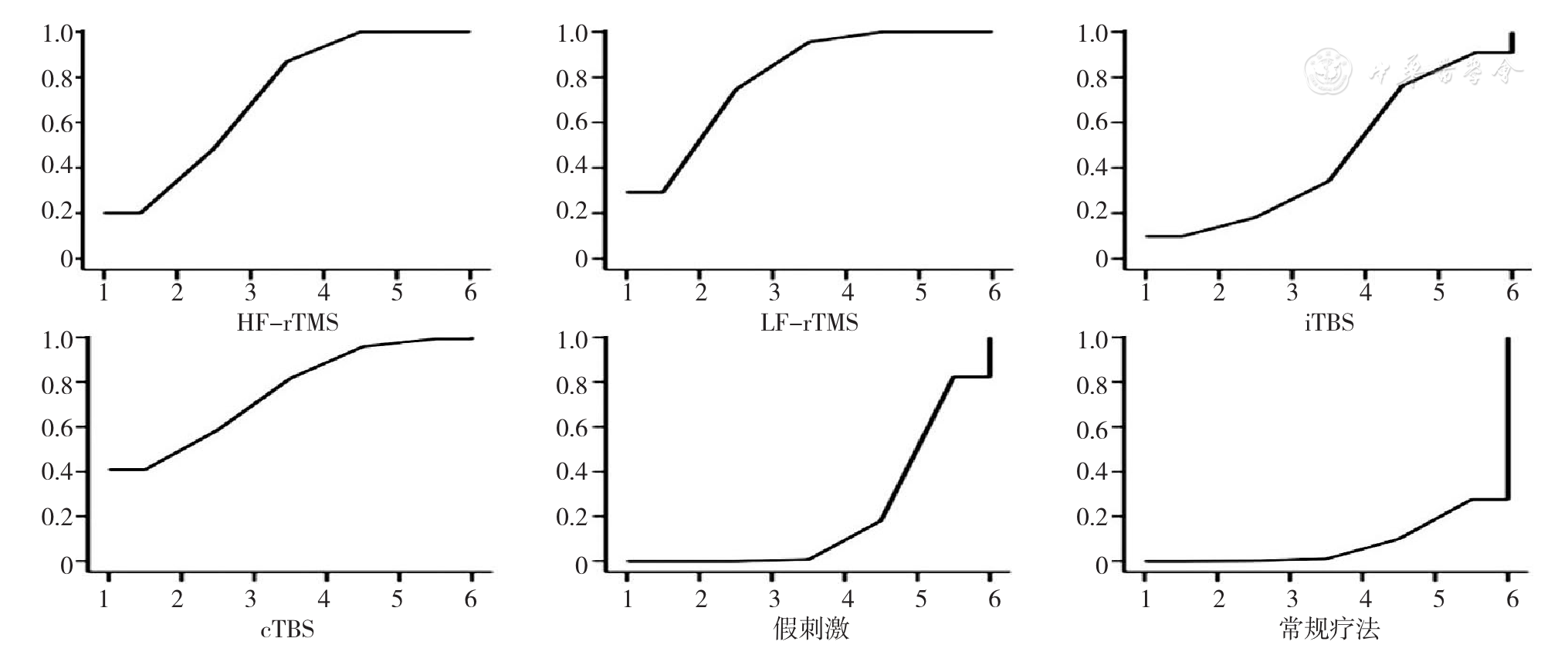
图3 不同rTMS干预模式提高脑卒中后上肢运动障碍患者FMA-UE评分的SUCRA排序图注:以上各图横坐标均为干预措施排序,纵坐标均为累积排序概率曲线下面积
Figure 3 SUCRA of different rTMS intervention modalities in increasing the FMA-UE score in stroke patients with upper limb motor dysfunction
| 干预方案 | HF-rTMS | LF-rTMS | iTBS | cTBS | 假刺激 |
|---|---|---|---|---|---|
| LF-rTMS | -0.24(-0.94,0.45) | — | — | — | — |
| iTBS | -0.50(-1.43,0.44) | -0.25(-1.26,0.75) | — | — | — |
| cTBS | -0.28(-1.46,0.89) | -0.04(-1.28,1.20) | 0.21(-1.17,1.60) | — | — |
| 假刺激 | 0.05(-0.37,0.46) | 0.29(-0.27,0.85) | 0.54(-0.29,1.38) | 0.33(-0.77,1.43) | — |
| 常规疗法 | 0.14(-0.94,1.23) | 0.39(-0.45,1.22) | 0.64(-0.67,1.95) | 0.43(-1.06,1.92) | 0.10(-0.91,1.10) |
表7 不同rTMS干预模式降低脑卒中后上肢运动障碍患者MAS评分的网状Meta分析〔SMD(95%CI)〕
Table 7 Network meta-analysis of different rTMS intervention modalities in decreasing the MAS score in stroke patients with upper limb motor dysfunction
| 干预方案 | HF-rTMS | LF-rTMS | iTBS | cTBS | 假刺激 |
|---|---|---|---|---|---|
| LF-rTMS | -0.24(-0.94,0.45) | — | — | — | — |
| iTBS | -0.50(-1.43,0.44) | -0.25(-1.26,0.75) | — | — | — |
| cTBS | -0.28(-1.46,0.89) | -0.04(-1.28,1.20) | 0.21(-1.17,1.60) | — | — |
| 假刺激 | 0.05(-0.37,0.46) | 0.29(-0.27,0.85) | 0.54(-0.29,1.38) | 0.33(-0.77,1.43) | — |
| 常规疗法 | 0.14(-0.94,1.23) | 0.39(-0.45,1.22) | 0.64(-0.67,1.95) | 0.43(-1.06,1.92) | 0.10(-0.91,1.10) |
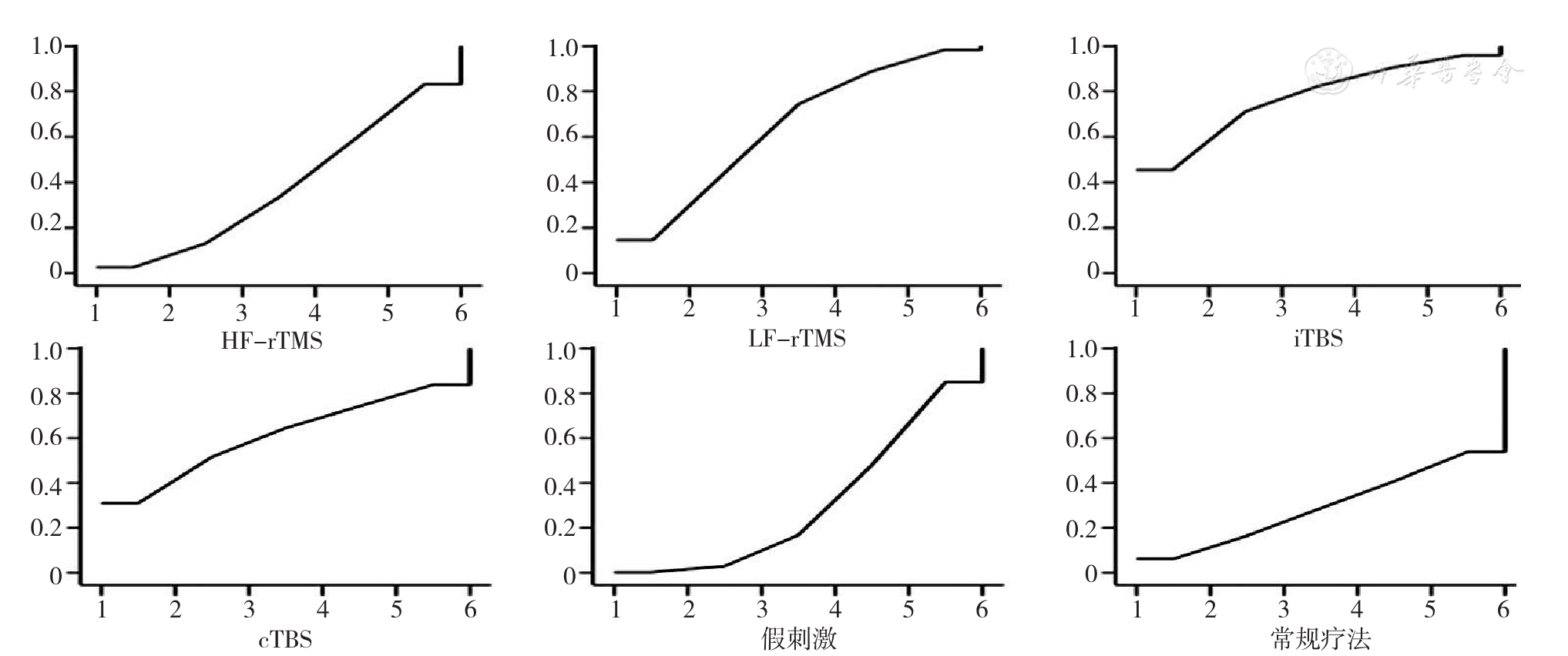
图4 不同rTMS干预模式降低脑卒中后上肢运动障碍患者MAS评分的SUCRA排序图注:以上各图横坐标均为干预措施排序,纵坐标均为累积排序概率曲线下面积
Figure 4 SUCRA of different rTMS intervention modalities in decreasing the MAS score for stroke patients with upper limb motor dysfunction
| 干预方案 | HF-rTMS | LF-rTMS | iTBS | 假刺激 |
|---|---|---|---|---|
| LF-rTMS | -0.87(-1.34,-0.39) | — | — | — |
| iTBS | -0.48(-1.17,0.20) | 0.38(-0.33,1.10) | — | — |
| 假刺激 | 0.04(-0.33,0.41) | 0.91(0.49,1.33)a | 0.53(-0.05,1.10) | — |
| 常规疗法 | 0.23(-0.16,0.63) | 1.10(0.66,1.54)a | 0.72(-0.03,1.46) | 0.19(-0.28,0.66) |
表8 不同rTMS干预模式提高脑卒中后上肢运动障碍患者MBI和BI评分的网状Meta分析〔SMD(95%CI)〕
Table 8 Network meta-analysis of different modalities of rTMS intervention in increasing the MBI and BI scores in stroke patients with upper limb motor dysfunction
| 干预方案 | HF-rTMS | LF-rTMS | iTBS | 假刺激 |
|---|---|---|---|---|
| LF-rTMS | -0.87(-1.34,-0.39) | — | — | — |
| iTBS | -0.48(-1.17,0.20) | 0.38(-0.33,1.10) | — | — |
| 假刺激 | 0.04(-0.33,0.41) | 0.91(0.49,1.33)a | 0.53(-0.05,1.10) | — |
| 常规疗法 | 0.23(-0.16,0.63) | 1.10(0.66,1.54)a | 0.72(-0.03,1.46) | 0.19(-0.28,0.66) |
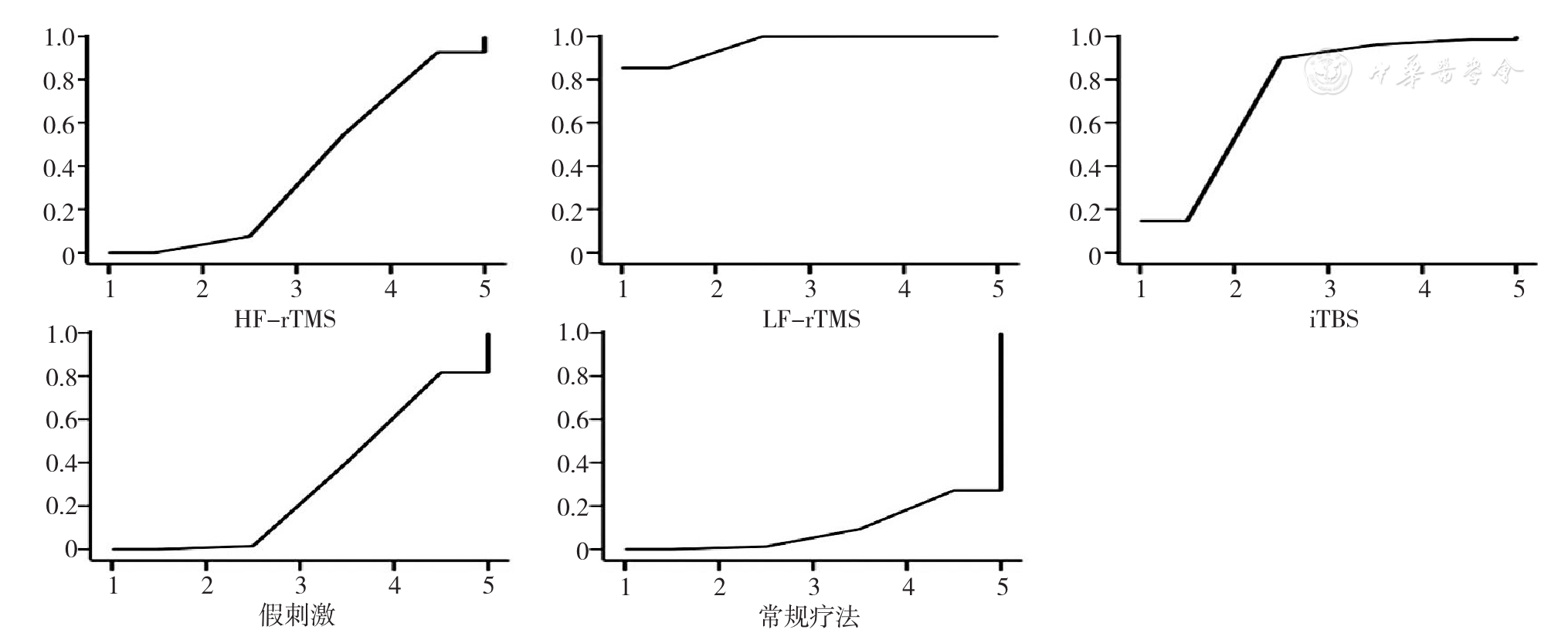
图5 不同rTMS干预模式提高脑卒中后上肢运动障碍患者MBI和BI评分的SUCRA排序图注:以上各图横坐标均为干预措施排序,纵坐标均为累积排序概率曲线下面积
Figure 5 SUCRA of different rTMS intervention modalities in increasing the MBI and BI scores for stroke patients with upper limb motor dysfunction
| 干预方案 | HF-rTMS | LF-rTMS | iTBS | 假刺激 |
|---|---|---|---|---|
| LF-rTMS | 0.02(-0.34,0.37) | — | — | — |
| iTBS | 0.69(-0.10,1.48) | 0.68(-0.09,1.44) | — | — |
| 假刺激 | 0.91(0.55,1.28)a | 0.90(0.59,1.20)a | 0.22(-0.48,0.92) | — |
| 常规疗法 | 0.22(-0.51,0.94) | 0.20(-0.43,0.83) | -0.48(-1.47,0.52) | -0.70(-1.40,0) |
表9 不同rTMS干预模式缩短脑卒中后上肢运动障碍患者MEP潜伏期的网状Meta分析〔SMD(95%CI)〕
Table 9 Network meta-analysis of different rTMS intervention modalities in reducing the MEP latency in stroke patients with upper limb motor dysfunction
| 干预方案 | HF-rTMS | LF-rTMS | iTBS | 假刺激 |
|---|---|---|---|---|
| LF-rTMS | 0.02(-0.34,0.37) | — | — | — |
| iTBS | 0.69(-0.10,1.48) | 0.68(-0.09,1.44) | — | — |
| 假刺激 | 0.91(0.55,1.28)a | 0.90(0.59,1.20)a | 0.22(-0.48,0.92) | — |
| 常规疗法 | 0.22(-0.51,0.94) | 0.20(-0.43,0.83) | -0.48(-1.47,0.52) | -0.70(-1.40,0) |
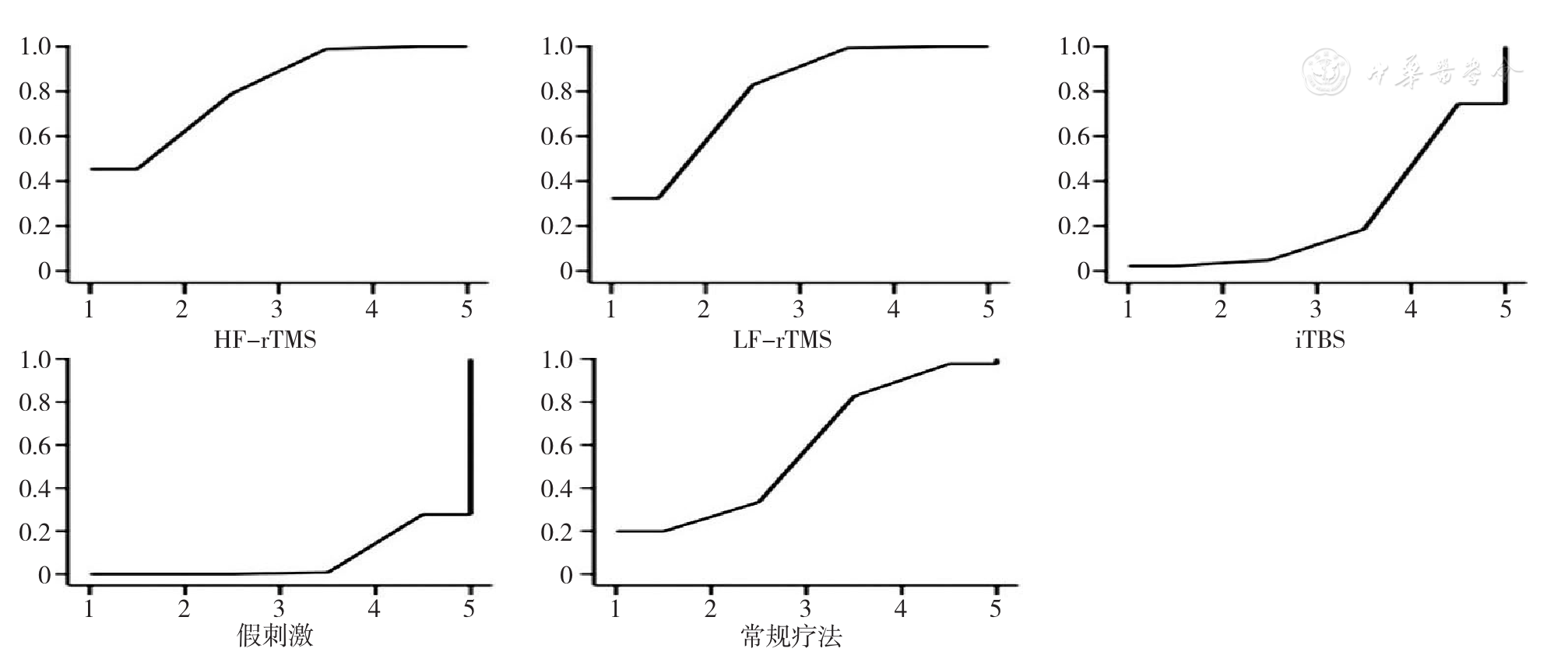
图6 不同rTMS干预模式缩短脑卒中后上肢运动障碍患者MEP潜伏期的SUCRA排序图注:以上各图横坐标均为干预措施排序,纵坐标均为累积排序概率曲线下面积
Figure 6 SUCRA of different rTMS intervention modalities in reducing the MEP latency in stroke patients with upper limb motor dysfunction
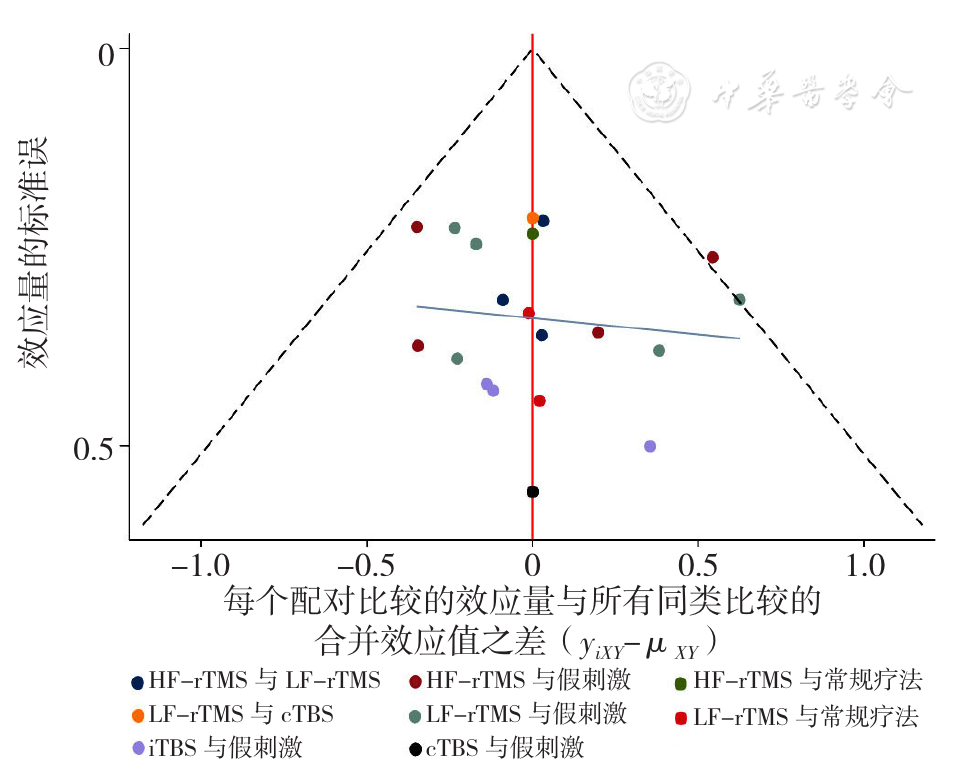
图7 不同rTMS干预模式在提高脑卒中后运动功能障碍患者FMA-UE评分方面的校正比较漏斗图
Figure 7 Corrected funnel plots for different rTMS intervention modalities in increasing the FMA-UE score in stroke patients with upper limb motor dysfunction
| [1] |
孙海欣,王文志. 我国脑卒中流行状况及其防控策略[J]. 中华神经科杂志,2017,50(12):881-884. DOI:10.3760/cma.j.issn.1006-7876.2017.12.001.
|
| [2] |
|
| [3] |
|
| [4] |
|
| [5] | |
| [6] |
|
| [7] |
中华医学会神经病学分会,中华医学会神经病学分会脑血管病学组. 中国各类主要脑血管病诊断要点2019[J]. 中华神经科杂志,2019,52(9):710-715. DOI:10.3760/cma.j.issn.1006-7876.2019.09.003.
|
| [8] |
李静,李幼平. 不断完善与发展的Cochrane系统评价[J]. 中国循证医学杂志,2008,8(9):742-743.
|
| [9] |
肖长林,潘翠环,陈艳,等. 不同频率高频重复经颅磁刺激对缺血性脑卒中患者上肢功能的效果[J]. 中国康复理论与实践,2019,25(5):557-563. DOI:10.3969/j.issn.1006-9771.2019.05.011.
|
| [10] |
梁绮婷,钟燕桃,施晓耕,等. 高频重复经颅磁刺激对脑卒中患者上肢运动及感觉功能的影响[J]. 中华老年心脑血管病杂志,2018,20(11):1187-1190. DOI:10.3969/j.issn.1009-0126.2018.11.016.
|
| [11] |
周哲,沈夏锋,熊莉,等. 运动前区高频重复经颅磁刺激对脑卒中上肢功能康复的疗效[J]. 中国康复理论与实践,2020,26(6):697-702. DOI:10.3969/j.issn.1006-9771.2020.06.014.
|
| [12] |
王玉琴,吕铭新,刘双洁,等. 高剂量低频健侧重复经颅磁刺激对脑梗死后上肢运动功能的影响[J]. 中国生物医学工程学报,2020,39(4):508-512. DOI:10.3969/j.issn.0258-8021.2020.04.015.
|
| [13] |
刘阅,王晓阳,张长龙,等. 低频重复经颅磁刺激改善脑卒中后上肢痉挛的任务态功能磁共振研究[J]. 中国康复理论与实践,2018,24(7):828-833. DOI:10.3969/j.issn.1006-9771.2018.07.014.
|
| [14] |
李冰洁,李芳,张通. 不同强度低频重复经颅磁刺激对脑卒中后上肢运动功能障碍的疗效[J]. 中国康复理论与实践,2016,22(9):1004-1007.
|
| [15] |
|
| [16] |
|
| [17] |
汤昕未,胡瑞萍,朱玉连,等. 间歇性θ短阵脉冲刺激对脑卒中后运动功能障碍的影响[J]. 中国康复医学杂志,2018,33(12):1410-1415. DOI:10.3969/j.issn.1001-1242.2018.12.006.
|
| [18] |
|
| [19] |
|
| [20] |
|
| [21] |
|
| [22] |
|
| [23] |
|
| [24] |
孟祥民,赵宇阳,杨传美,等. 重复经颅磁刺激对脑梗死患者上肢运动功能的影响[J]. 中国康复医学杂志,2016,31(6):664-669. DOI:10.3969/j.issn.1001-1242.2016.06.010.
|
| [25] |
|
| [26] |
|
| [27] |
|
| [28] |
|
| [29] |
|
| [30] |
|
| [31] |
|
| [32] |
|
| [33] |
|
| [34] |
陈娟,林慈宽,程丽芳. 低频rTMS刺激联合早期康复运动对缺血性脑卒中患者运动、语言功能恢复的影响[J]. 海南医学,2021,32(15):1922-1925. DOI:10.3969/j.issn.1003-6350.2021.15.005.
|
| [35] |
|
| [36] |
|
| [37] |
|
| [38] |
|
| [39] |
|
| [40] |
|
| [41] |
|
| [42] |
|
| [43] |
|
| [44] |
|
| [45] |
|
| [46] |
|
| [47] |
|
| [48] |
|
| [49] |
|
| [1] | 全家霖, 朱琳, 苏煜, 陈泽恺, 陈梓淇, 张卓凡. 运动方式对超重或肥胖儿童青少年执行功能改善效果的网状Meta分析[J]. 中国全科医学, 2025, 28(27): 3422-3431. |
| [2] | 聂丹宁, 史曙生, 陶昱如. 本体感觉神经肌肉促进技术联合螺旋稳定肌肉链训练治疗青少年特发性脊柱侧弯的临床效果研究[J]. 中国全科医学, 2025, 28(24): 3032-3042. |
| [3] | 李浩, 李江涛, 刘丹, 王建军. 贝利尤单抗和阿尼鲁单抗及泰它西普治疗系统性红斑狼疮疗效和安全性的网状Meta分析[J]. 中国全科医学, 2025, 28(23): 2924-2933. |
| [4] | 杨继, 张垚, 赵英强, 张秋月. 中医三级防控模式对冠心病与脑卒中患者的管理效能评价:一项单中心前瞻性队列研究[J]. 中国全科医学, 2025, 28(22): 2750-2761. |
| [5] | 文敏, 周永玲, 刘静静, 蒋苛晴, 刘娟, 朱晓丹. 基于移动医疗APP的认知补偿训练对稳定期精神分裂症患者的干预效果与机制研究[J]. 中国全科医学, 2025, 28(22): 2819-2825. |
| [6] | 杨涵单, 乔雯, 何姝, 陈易, 童云梅. 接纳承诺疗法联合舍曲林对抑郁症青少年抑郁情绪、自杀意念及睡眠质量的影响研究[J]. 中国全科医学, 2025, 28(22): 2813-2818. |
| [7] | 王颖, 颜轶隽, 刘蕾, 胡毓敏, 张扬, 刘凯, 姜博仁. 抗阻力运动联合营养干预对老年2型糖尿病合并肌少症患者血糖稳定性影响的临床研究[J]. 中国全科医学, 2025, 28(21): 2604-2610. |
| [8] | 谈毅, 祝丽红, 尹增维, 侯舒喃, 俞厚明. 磁共振成像指导急性缺血性脑卒中静脉溶栓治疗效果的真实世界研究[J]. 中国全科医学, 2025, 28(20): 2508-2515. |
| [9] | 褚田雨, 顾艳. 颈动脉钙化特征在评估斑块稳定性及临床事件中的作用[J]. 中国全科医学, 2025, 28(18): 2247-2252. |
| [10] | 谭文彬, 李佳, 刘明玉, 路永欣, 程雅欣. 神经系统疾病及相关治疗药物对骨质疏松症影响的研究进展[J]. 中国全科医学, 2025, 28(17): 2092-2100. |
| [11] | 何芸, 范焕芳, 马盼, 许绍青, 杨柳, 金明哲, 张明蕊, 陈佳琪. 不同针灸治疗方式干预乳腺癌术后上肢淋巴水肿效果的网状Meta分析[J]. 中国全科医学, 2025, 28(14): 1788-1794. |
| [12] | 朱胜杰, 刁华琼, 杭晓屹, 孙文军. 不同中成药注射液治疗后循环缺血性眩晕效果的网状Meta分析[J]. 中国全科医学, 2025, 28(14): 1795-1808. |
| [13] | 李玫, 蒋东升, 赵晶晶, 曹亚景, 张帆, 唐丽娟, 刘晓丽. 40岁及以上人群同型半胱氨酸与脑卒中的关系研究[J]. 中国全科医学, 2025, 28(14): 1723-1729. |
| [14] | 郭鑫, 周明娟, 范斐婷, 肖晶旻, 池逸和, 吴蕾, 林琳, 陈远彬. 天灸散穴位贴敷治疗支气管哮喘前期的随机对照研究[J]. 中国全科医学, 2025, 28(11): 1367-1375. |
| [15] | 迟洵, 刘思思, 陈巧, 胡玥, 王伟仙. 不同营养筛查工具对肝硬化患者营养筛查适用性的网状Meta分析[J]. 中国全科医学, 2025, 28(11): 1395-1402. |
| 阅读次数 | ||||||
|
全文 |
|
|||||
|
摘要 |
|
|||||





